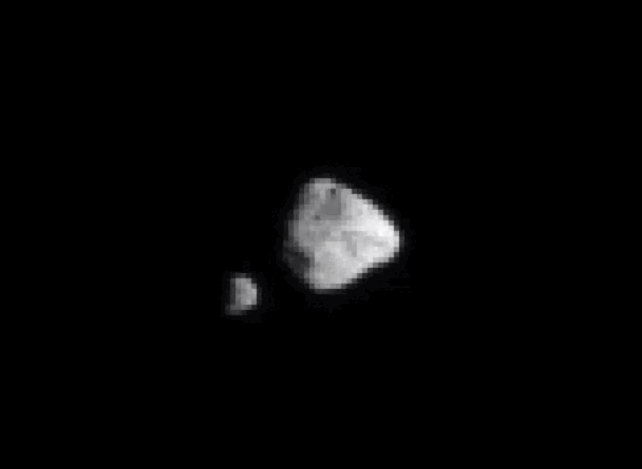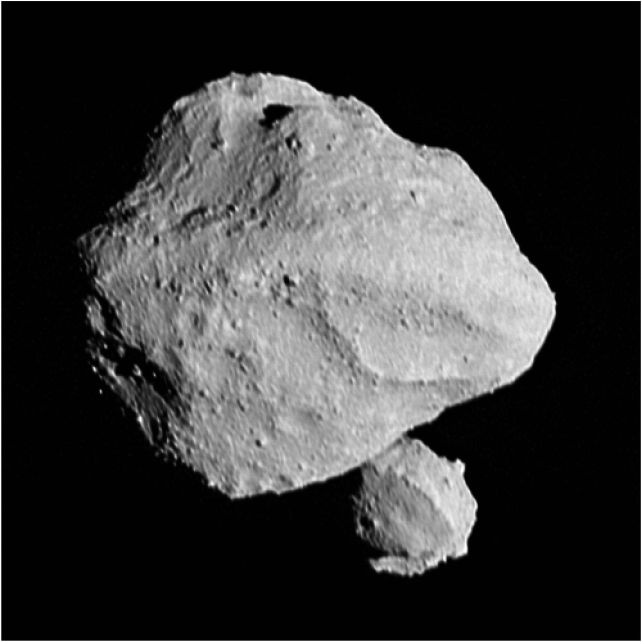NASA asteroid probe Lucy found a huge surprise when it completed the first of its flybys of its asteroid targets.
Asteroid Dinkinesh, hanging around in the main belt that orbits between Mars and Jupiter, is not alone. The chunk of gray space rock has its own tiny little asteroid moon, wrapped in a close orbit – too close to be discerned from a large distance.
The discovery suggests that there could be many more binary asteroids out there than we know – a preponderance that could help us understand how rocks in the Solar System grow and interact.
"We have seen many asteroids up close, and one may think little is left to discover and surprise us," says planetary scientist Simone Marchi of the Southwest Research Institute (SwRI).
"Well, that is clearly wrong. Dinkinesh, and its enigmatic moonlet, differ in some interesting ways from the similarly sized near-Earth asteroids that have been seen by spacecraft like OSIRIS-REx and DART."

We know of a number of binary, trinary, and even one quaternary asteroids hanging around the Solar System, but it's unclear exactly how many of them hang around in these bound groups. We've even seen an object that seems to have formed from space rocks that smushed together.
Asteroids do tend to hang out together – there's the main belt, of course, and the swarms of Trojan asteroids that share the orbit of Jupiter – but how often they come into close enough proximity to each other to become gravitationally bound is unclear.
Scientists gained an inkling that Dinkinesh may have a moon in the weeks as Lucy approached the asteroid. The object's brightness kept changing; this is often a sign that there is a second object popping in and out of view as the binary orbits, contributing to and subtracting from the overall light reflected by the asteroid.
When Lucy finally got close enough to take detailed pictures, the suspicions were confirmed. As Lucy flew by at 16,100 kilometers (10,000 miles) per hour, it clearly observed two objects, engaged in a close orbital dance.
The larger rock, preliminary measurements suggest, is about 790 meters (2,600 feet) at its widest point, while the smaller is a relatively titchy 220 meters (720 feet).

"We knew this was going to be the smallest main belt asteroid ever seen up close," says planetary astronomer Keith Noll of NASA's Goddard Space Flight Center.
"The fact that it is two makes it even more exciting. In some ways these asteroids look similar to the near-Earth asteroid binary Didymos and Dimorphos that DART saw, but there are some really interesting differences that we will be investigating."
Asteroids, particularly those that hang out in Jovian orbit, are thought to be made of the materials that made up the planets in the early days of the Solar System, in relatively pristine condition.
Lucy's mission is to study these asteroids to learn more about how the Solar System formed, and how the planets got here. During its 12-year mission, it will check out two main belt asteroids, and nine Trojans.
Since at least some of the planets – the rocky worlds of the inner Solar System – are thought to have formed from smaller rocks accumulating and smushing together, finding more binaries like Dinkinesh could help us better understand how this process works.
It's going to take a little more time to finish extracting the rest of the Dinkinesh data from Lucy. This will not just give us information about the asteroid, but how Lucy is operating.
In the meantime, the spacecraft is on its way to the second of its main belt encounters, the asteroid Donaldjohanson, a rendezvous that will take place in 2025.
Science - Latest - Google News
November 06, 2023 at 11:50AM
https://ift.tt/pJoWxdc
NASA Probe Discovers a Hidden Surprise During Asteroid Flyby - ScienceAlert
Science - Latest - Google News
https://ift.tt/R2SQVXj
https://ift.tt/iwvDJNm
Bagikan Berita Ini

















0 Response to "NASA Probe Discovers a Hidden Surprise During Asteroid Flyby - ScienceAlert"
Post a Comment